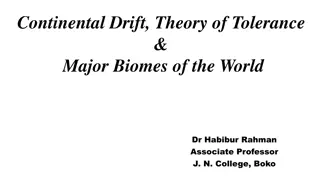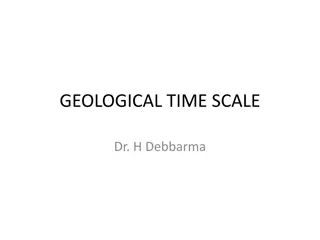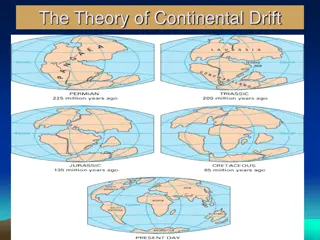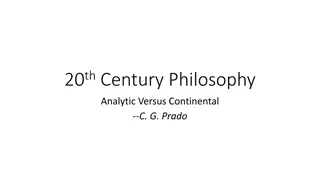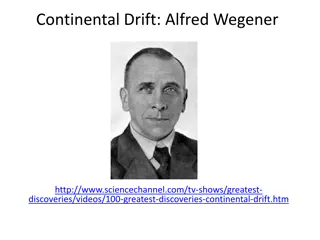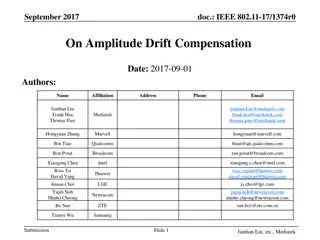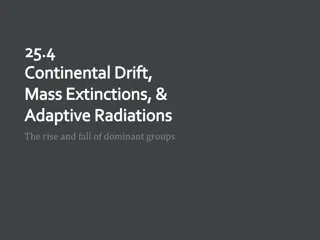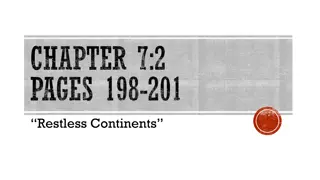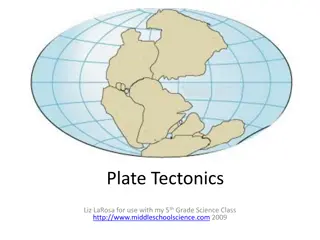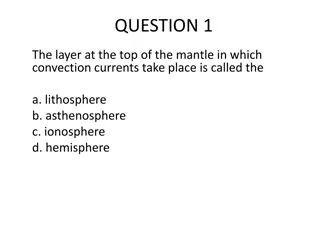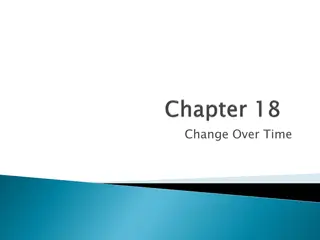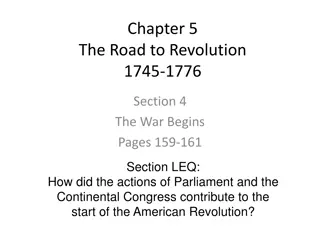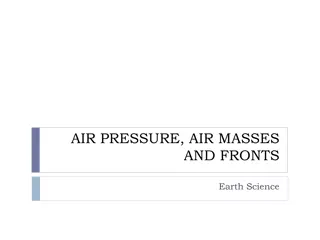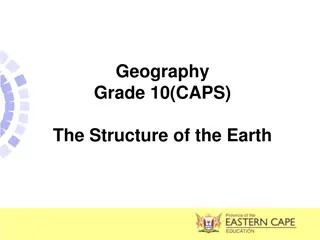Understanding Earth's Structure and Continental Drift Theories
Dutch mapmaker Abraham Ortelius noted the jigsaw fit of continents, leading to the theory of continental drift. Alfred Wegener proposed the movement of continents based on geological evidence, influencing plate tectonics theory. Earth's layers vary from the thick mantle to the solid inner core due to factors like extreme temperatures and pressure, causing geological events like earthquakes.
Download Presentation

Please find below an Image/Link to download the presentation.
The content on the website is provided AS IS for your information and personal use only. It may not be sold, licensed, or shared on other websites without obtaining consent from the author. Download presentation by click this link. If you encounter any issues during the download, it is possible that the publisher has removed the file from their server.
E N D
Presentation Transcript
In the late 1500s a Dutch mapmaker named Abraham Ortelius studied new maps of the world. He noticed that the Americas seemed to fit with Europe and Africa like pieces in a jigsaw puzzle, as shown below. He suggested that the Americas were violently separated from Europe and Africa by earthquakes and floods. Which evidence would Alfred Wegener have presented to show that the continents have moved over time? A.Similar plants grow in Africa and Asia today. B. Similar animals live in North America and South America. C. Rocks found in Europe have minerals that are identical to those in different rock types found in Asia. In 1872 a Frenchman, Elisee Reclus, proposed that the continents drifted in a random way, but he didn t know why. He suggested that their collisions formed mountain ranges and caused earthquakes, as well as leaving empty places for oceans. An American, Frank B. Tailor, suggested that gravitational or tidal forces caused by the moon were responsible for the movement of the continents. In 1912 Alfred Wegener of Germany proposed the theory of continental drift, based on geology and fossils. He thought the continents somehow pushed their way through the ocean floor, but couldn t say what might cause that to happen. His theory led to the present-day theory of plate tectonics. D.Fossils of tropical plants are found in Antarctica, and glacial deposits are found in hot, dry parts of Africa.
Which scientist in the passage first described how moving continents cause some landforms and geological events? a. Abraham Ortelius b. Alfred Wegener c. Frank B. Tailor d. Elisee Reclus
Which of the following best describes the inner core of Earth? A. gas B. liquid C. solid D. vapor
Earth is made of different layers that have varying characteristics. Which is the thickest layer? A.the mantle B.the inner core C.the outer core D.the crust
The inner core of Earth is solid because of the A.rate of rotation. B.extreme temperature. C.amount of pressure. D.magnetic field.
Which layer of the Earth has the most mass? A.Inner core B.Outer core C.Lower mantle D.Transition region
In what section of Earth do earthquakes happen? A.Crust B.Mantle C.Inner core D.Outer core
Use the diagram to answer the question that follows. Which is the correct order of Earth s layers, from outside to inside? A. crust, core, mantle B. crust, mantle, core C. mantle, crust, core D. core, crust, mantle
Which of the following has the greatest direct influence on movement of the lithosphere? A.the Sun B.the Moon C.Earth s core D.Earth s mantle
A student uses clay to build models of an ocean plate and a continental plate. What characteristic cannot be accurately represented by the models? A.the shapes of plates B.the relative sizes of plates C.the relative densities of plates D.the arrangement of plates relative to one another
Use the following diagram. Name the center of Earth and give one of its characteristics.
This map shows the boundaries of Earths major tectonic plates. Which numbered area on the map represents the African Plate? A. 1 B. 2 C. 3 D. 4
Look at the map below. The dots around the Pacific Ocean show where earthquakes happened. Is the land under most of the Pacific Ocean made of one tectonic plate or two? Support your answer. What other kind of sudden geologic event is also likely to happen on the land around the Pacific Ocean?
This diagram shows one way that lithospheric plates can interact. Which result will the movement of these two plates most likely cause? A.Volcanoes B.earthquakes C. ocean spreading D.mountain building
Lithospheric plates have moved to form land formations on the Earth's surface. Which land formation occurs as a result of the plates folding upon one another? A. an earthquake B. a mountain range C. a river D. a volcano
The map shows where llamas and camels live. Camels and llamas are very closely related animals that live in places that are very far apart. The relationship between camels and llamas suggests that ________ A. air temperatures have gotten higher. B. the oceans have gotten larger. C. weather patterns have changed. D. the continents have drifted.
The map shows a boundary between two tectonic plates. Between which two tectonic plates is this boundary located? A. Indo-Australian Plate and Pacific Plate B. North American Plate and Pacific Plate C. Indo-Australian Plate and Eurasian Plate D. North American Plate and Eurasian Plate
Scientists estimate that the temperature of Earths core is as high as 6000 C. Which best explains how heat from the core reaches the surface? A. Hot materials in the mantle circulate the same way warm air rises and cool air sinks in a heated room. B. Energy is released as molecules in the mantle form new compounds that flow toward the crust. C. Energy from atoms vibrating near the core passes through the mantle until it reaches the crust. D. Heat from the core radiates through the mantle the same way sunlight passes through space.
This map shows the borders of Earths major tectonic plates. Which tectonic plate is directly south of the African Plate? A. North American Plate B. Antarctic Plate C. Pacific Plate D. Nazca Plate
Different processes cause Earth to change. Which process causes earthquakes, mountain building, and volcanic action? A.movement of tectonic plates B.pull of the Moon s gravity C.deposition of sediments D.erosion of rocks
The picture represents the formation of the Himalaya Mountains. Which two plates collided with each other to form the Himalaya Mountains? A.Nazca and Eurasian B.Indo-Australian and Eurasian C.North American and Antarctic D.South American and Indo-Australian
Kiesha and Martin created a presentation for their class about a volcanic eruption. This was their introduction: Mount Tambora, a volcano in the Indian Ocean, erupted dramatically in April of 1815. The eruption was so powerful that Mount Tambora decreased by one-third its original height. The explosion was heard over 2000 km (1200 miles) away. Huge amounts of dust and ash were ejected into the upper atmosphere. Air currents gradually carried the ash around the planet. The volcanic ash significantly changed the climate of North America. Cattle and crops died. Weather was unusually cold for over a year. In fact, the year 1816 is known as the year without summer. They concluded that Mount Tambora s eruption of 1815 was a sudden, large-scale geologic event. Most sudden geologic events happen on a small scale, and most large-scale events are gradual, so their claim needs consideration. Evaluate the students claim. Support your evaluation with facts from their presentation.
When a layer of intrusive rock enters into other layers then the intrusive rock layer ________ A.is older than the other layers. B.is younger than the other layers. C.has less mass than the other layers. D.has more mass than the other layers.
Paleontologists have found hundreds of fossils of tropical plants in cool, dry areas of North America. Which is most likely indicated by fossil discoveries like these? A.Glacial movement carried fossils to different places. B.Some tropical plants can grow in moderate climates. C. The climate in different areas on Earth has changed over time. D.Ancient people carried plants with them as they traveled to new locations.
Which of the following is the most likely cause of earthquakes? A.shifting rock layers B.crashing meteorites C.rotation of the core D.magnetic force
Earthquakes occur along the San Andreas Fault in California. Which statement best describes plate motion in the area during the time between earthquakes? A.Plate motion stops, and plate tension decreases. B.Plate motion continues, and plate tension increases. C.Plate motion stops, and only the mantle moves. D.Plate motion reverses, and plates return to their original positions.
Which event most likely caused the formation of folded mountain ranges? A. Tectonic plates on the earth pushed together. B. Tectonic plates on the earth pulled apart. C. Tectonic plates on the earth slid past each other. D. Tectonic plates on the earth broke into small pieces.



